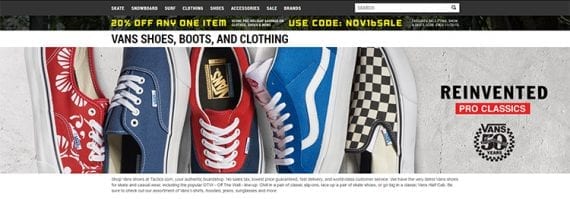Often product suppliers will help small and mid-sized retail businesses pay for the cost of advertising and promotion. The thinking goes that when a retailer, like an online store, promotes a product, both the retailer and the supplier benefit. Thus both should share the cost of advertising.
This mutually beneficial relationship is typically called coöperative advertising — co-op. Small businesses like it because it can cut advertising expenses significantly. Manufacturers and distributors like it because their products are being advertised.
Often co-op is based on a percentage of a retailer’s annual wholesale purchases. If your online shop buys 10,000 worth of scarves, that scarf supplier might offer two-or-three percent in co-op or about $200 or $300 dollars at, say, 50 percent. Thus, if you spend $600 on pay-per-click advertising, as an example, the manufacturer would reimburse your business for half of the cost.
While co-op can be a boon to your store’s advertising budget, it is not necessarily problem free. What follows are five tips for dealing with co-op advertising.
1. Get Approval Before You Place Ads
To get the most out of co-op advertising, have each ad approved before you place it. Suppliers frequently have co-op requirements that you must meet in order to receive your co-op reimbursement.
As an example, if you wanted to do a commercial on a popular podcast and promoted a brand like Wrangler, you would need to ensure that Wrangler’s name was mentioned three times in a 30-second spot. Mention it just twice and Wrangler might not reimburse you.
However, if you had sent that same spot to Wrangler in advance and the company approved it, you would be sure to get paid.
Bottom line, get every co-op ad approved before it is placed. It is a little extra work, but it ensures that your co-op claim will not be rejected.
2. Customize Your Ads
It is common for product suppliers to offer stock ads to retailers. These are pre-made web banners, print ads, or even scripts for commercials.

This is an example of two Wrangler stock banner ads that Wrangler retailers may use for co-op ads. While these ads might work well, you can often create your own, brand-specific ads, get them approved, and still receive co-op.
While these can be easier to place, they may not represent your brand or even fit your customers. If there is no difference in the co-op reimbursement rate, consider using these manufacturer-supplied ads to inspire your own custom versions.
Be certain to get your custom ads approved before you place them, as recommended in tip number one above.
3. Create Co-op Advertising Opportunities
One of the best ways to maximize co-op is to have an advertising product you can sell directly to a supplier.
As an example, a multichannel retailer in the northwest U.S. has a long-running radio program and podcast. The show is focused on gardening, and the retailer has hired a certified master gardener to host it. Each episode includes six, one-minute commercials. All of the commercials are for products the retailer sells.
This retailer charges $625 in co-op per commercial per month, for $3,750 in total monthly co-op reimbursements. The co-op collected more than covers the expense of buying radio time, producing the radio show and podcast, and paying the host a very good wage.
Similarly, an online store might charge a manufacturer co-op for a brand landing page. This is a page devoted specifically to a particular product maker. It may include additional copy, videos promoting the brand, and, of course, all of the brand’s products. Some online retailers charge as much as $1,000 per month in co-op for a brand landing page.

Retailers may be able to charge suppliers co-op for branded landing pages like this Van’s page.
4. Ask for Over-and-above Money
When you have a special project or promotion, you can ask for over-and-above money for business development. Typically, you would need a history of using all available co-op for a particular supplier before you can ask for over and above money. But, that caveat aside, suppliers will often pay for promotions for a good retailer.
As an example, imagine that you’ve grown your business enough that you have a truck to pick up items from suppliers and transport those items to your warehouse. A supplier might pay for a custom graphic on your truck.
Or if you wanted to have a booth at a popular trade show that is not part of your normal advertising, a supplier might pay for it with over-and-above money.
5: Don’t Let Co-op Drive Your Marketing
Be careful not to let co-op drive your advertising plan completely. Otherwise, you may find you’re not promoting your best products or you’re spending a lot more on advertising than you intended.
Take the first concern. How might co-op cause you to promote the wrong products or at least not the best products?
Imagine that you have an advertising budget of $1,000. You have two products to sell. Product A comes with $500 worth of co-op at 50 percent. So if you spend all of your $1,000 budget on Product A, you’ll get reimbursed $500 in co-op. You would therefore save money on advertising. But in this case, you would not have done any advertising for Product B, which may have a higher margin and a better conversion rate. You may have made more money overall if you had forgone some of the co-op and promoted your best product.
But why not spend $1,500 on advertising and take the $500 in co-op, so that the final expense is still just $1,000? That is the second point: Co-op can sometimes cause you to spend more on advertising.
If co-op reimbursements were instant, this would not be much of a problem. But they are not. Typically a business will wait 30 to 60 days for a co-op claim to be processed. So you many need to float the additional advertising expenses.
For example, a popular work boot manufacturer based in the western U.S. pays its retailers 100-percent co-op. But it only reimburses them quarterly. So while a retailer can get all of its advertising investment back, it would still need the cash flow to support that advertising for up to three months.
Co-op advertising can help small and mid-sized retailers manage the cost of promotions. But do not let co-op be the sole reason to promote.




